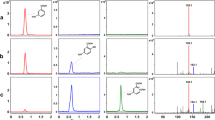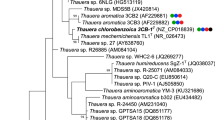Abstract
The gene dehalA encoding a novel dichloromethane dehalogenases (DehalA), has been cloned from Bacillus circulans WZ-12 CCTCC M 207006. The open reading frame of dehalA, spanning 864 bp, encoded a 288-amino acid protein that showed 85.76% identity to the dichloromethane dehalogenases of Hyphomicrobium sp. GJ21 with several commonly conserved sequences. These sequences could not be found in putative dichloromethane (DCM) dehalogenases reported from other bacteria and fungi. DehalA was expressed in Escherichia coli BL21 (DE3) from a pET28b(+) expression system and purified. The subunit molecular mass of the recombinant DehalA as estimated by sodium dodecyl sulfate–polyacrylamide gel electrophoresis was approximately 33 kDa. Subsequent enzymatic characterization revealed that DehalA was most active in a acidic pH range at 30°, which was quite different from that observed from a facultative bacterium dichloromethane dehalogenases of Methylophilus sp. strain DM11. The Michaelis–Menten constant of DCM dehalogenase was markedly lower than that of standard DCM dehalogenases.





Similar content being viewed by others
Abbreviations
- DCM:
-
Dichloromethane
- DehalA:
-
Dichloromethane dehalogenases from Bacillus circulans WZ-12
- dehalA :
-
Gene encoding DehalA
- dehA :
-
Dichloromethane dehalogenases of Hyphomicrobium sp. GJ21
- K m :
-
Michaelis–Menten constant
- SDS–PAGE:
-
Sodium dodecyl sulfate–polyacrylamide gel electrophoresis
References
Vuilleumier S, Sorribas H, Leisinger T (1997) Identification of a novel determinant of glutathione affinity in dichloromethane dehalogenases/glutathione S-transferase. Biochem Biophys Res Commun 238:452–456
Vuilleumier S, Leisinger T (1996) Protein engineering studies of dichloromethane dehalogenase/glutathione S-transferase from Methylophilus sp. strain DM11. Ser12 but not Tyr6 is required for enzyme activity. Eur J Biochem 239:410–417
Van Pee KH, Unversucht S (2003) Biological dehalogenation and the halogenation reactions. Chemosphere 52:299–312
Schmid-Appert M, Zoller K, Traber H, Vuilleumier S, Leisinger T (1997) Association of newly discovered IS elements with the dichloromethane utilization genes of methylotrophic bacteria. Microbiology 143:2557–2567
Goodwin KD, Schaefer JK, Oremland RS (1998) Bacterial oxidation of dichloromethane and methyl bromide in natural waters and enrichment cultures. Appl Environ Microbiol l64:4629–4636
Pries F, van der Wijngaard J, Bos AJ, Pentenga RM, Janssen DB (1994) The role of spontaneous cap domain mutations in haloalkane dehalogenase specifity and evolution. J Biol Chem 26:17490–17494
Chung JG, Lu HF, Yeh CC, Cheng KC, Lin SS, Lee JH (2004) Inhibition of N-acetyltransferase activity and gene expression in human colon cancer cell lines by diallyl sulfide. Food Chem Toxicol 42(2):195–202
Bader R, Leisinger T (1994) Isolation and characterization of the Methylophilus sp. strain DM11 gene encoding DCM dehalogenases/glutathione S-transferase. J Bacteriol 176:3466–3473
Gisi D, Willi L, Traber H, Leisinger T, Vuilleumier S (1998) Effects of bacterial host and DCM dehalogenases on the competitiveness of methylotrophic bacteria growing with dichloromethane. Appl Environ Microbiol 64:1194–1202
Scholtz R, Wackett LP (1988) Dichloromethane dehalogenase with improved catalytic activity isolated from a fast-growing dichloromethane-utilizing bacterium. J Bacteriol 170(12):5698–5704
Sutherland JD (2000) Evolutionary optimisation of enzymes. Curr Opin Chem Biol 4:263–269
Scholtz R, Wackett LP, Egli C, Cook AM, Leisinger T (1988) Dichloromethane dehalogenase with improved catalytic activity isolated from a fast-growing dichloromethane-utilizing bacterium. J Bacteriol 170:5698–5704
Marmur J (1961) A procedure for the isolation of deoxyribonucleic acid from microorganisms. Mol Biol 3:208–218
Sambrook J, Fritsch EF, Maniatis T (1989) Molecular cloning: a laboratory manual, vol. 3, 2nd edn. Cold Spring Harbor Laboratory, Cold Spring Harbor, USA
Salome D, Roche LA, Leisinger T (1990) Sequence analysis and expression of the bacterial dichloromethane dehalogenase structural gene, a member of the glutathione S-transferase supergene family. J Bacteriol 172:161–171
Doronina NV, Trotsenko YA, Tourova TP (2000) Methylophila helvetica sp. nov. and Methylobacterium dichloromethanicum sp. nov.–novel aerobic facultatively methylotrophic bacteria utilizing dichloromethane. Syst Appl Microbiol 23:210–218
Gälli R, Leisinger T (1988) Plasmid analysis and cloning of the dichloromethane-utilization genes of Methylobacterium sp. DM4. J Gen Microbiol 134(4):943–952
Vuilleumier S, Pagni M (2002) Bacterial glutathione S-transferases: new lessons from bacterial genomes. Appl Microbiol Biotechnol 58:138–146
McDonald IR, Doronina NV, McAnulla C, Trotsenko YA, Murrell JC (2001) Hyphomicrobium chloromethanicum sp. nov. and Methylobacterium chloromethanicum sp. nov., chloromethane-utilizing bacteria isolated from a polluted environment. Int J Syst Evol Microbiol 51:119–122
Goenrich M, Bartoschek S, Hagemeier CH, Griesinger C, Vorholt JA (2002) A glutathione-dependent formaldehyde activating enzyme (Gfa) from Paracoccus denitrificans detected and purified via 2D proton exchange spectroscopy. J Biol Chem 277:3069–3072
Kohler-Staub D, Leisinger T (1985) Dichloromethane dehalogenase of Hyphomicrobium sp. strain DM2. J Bacteriol 162:676–681
Acknowledgments
The authors wish to thank the National High Technology Research and Development Program (“863”Program) of China (Grant No. 2006AA06A310) and the Natural Science Foundation of China (Grant No. 20476099) for the support of this study.
Author information
Authors and Affiliations
Corresponding author
Rights and permissions
About this article
Cite this article
Wu, S., Zhang, H., Yu, X. et al. Identification and cloning of a gene encoding dichloromethane dehalogenase from a methylotrophic bacterium, Bacillus circulans WZ-12 CCTCC M 207006. Bioprocess Biosyst Eng 32, 845–852 (2009). https://doi.org/10.1007/s00449-009-0311-3
Received:
Accepted:
Published:
Issue Date:
DOI: https://doi.org/10.1007/s00449-009-0311-3




